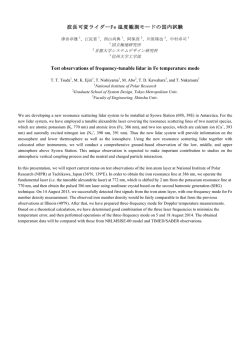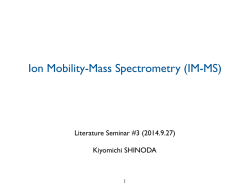
基質の結合によるタンパク質コンフォメーション変化における
基質の結合によるタンパク質コンフォメーション変化における イオンモビリティ測定 川瀬泰司 1、廣瀬賢治 1、押方基二 1、佐藤太 1、腹巻ゆかり 1、Iain Campuzano2、Keith Compson2、Therese McKenna2、James Langridge2、Rachel Garlish3 日本ウォーターズ株式会社 1、Waters Corporation MS Technologies Centre2、UCB Celltech Ltd3 ○ RESULTS OVERVIEW An increase in mass can be accurately measured upon the binding of substrate to BCL-XL BCL-XL 1700 1600 The change in the gas phase shape of BCL-XL is consistent to those made by NMR structural characterization techniques. R² = 0.9983 R² = 0.9978 R² = 0.9978 BCL-XL & BAK 1500 Binding of the substrate indicates a collapse from an larger unfolded structure to a more compact structure. 1400 ' a 1300 g e m O INTRODUCTION BCL-XL & BAD 1200 ナノエレクトロスプレーは生体高分子の気相イオンを効率よく生成することのできるイオン化法である。非共 1100 有結合により相互作用しているタンパク‐タンパク複合体の溶液中の構造を維持したまま、ほとんど構造 1000 に変化のない気相イオンを生成させることが可能である。 Figure 4. 重水素置換していない BCL-XL, BCL-XL & BAK および BCL-XL & BAD の 900 タンパク質の三次元構造の情報を得るための手法として、核磁気共鳴(NMR)や X 線結晶構造解析な マススペクトル 800 どが用いられているが、ここでは、BCL-XL タンパク質への基質の結合および、基質の結合による蛋白質 4 9 14 dt' 19 24 29 Analysing the protein BCL-XL under native conditions, the deconvoluted の変化を迅速に測定するための手法を提案する。基質の有無によるタンパク質の気相での形状を比較 し、NMR によって決定された溶液中における構造と一致することを実証した。 The instrument used in these studies was a Synapt HDMS System (Waters Corporation), shown in Figure 1, which has a hybrid quadrupole/IMS/oa-ToF samples were introduced Upon addition of ligand BAK the deconvoluted mass increases to 27,441Da Charge and reduced mass (BCL-XL & BAD). Upon addition of ligand BAD, the deconvoluted mass is 27,667Da (BCL-XL & BAD). Here we can demonstrate that a protein ligand Instrumentation Briefly, mass for the multiply charged ions m/z 2457, 2730 and 3071 is 24,562Da. T-Wave pulse height: 5.0, 5.5 and 6.0V. corrected CCS plotted against corrected drift-time. METHODS geometry. Figure 2. ミオグロビンおよびシトクロム C を用いた T-Wave 検量線. by a borosilcate glass nanoelectrospray-spray tip and sampled into the vacuum system through a ZSpray source. The ions pass through a quadrupole mass filter to the IMS section of the instrument. This section comprises three travelling wave (TWave) ion guides. The trap T-Wave accumulates ions whilst the previous mobility separation is occurring, then these ions are released in a packet into By utilising solution phase charge reduction, one can extend the ion complex mobility calibration, therefore reducing the need for linear extrapolation. spectrometer (Figure 4). be maintained during it’s transit through the mass As shown in Figure 2, using a solution of myoglobin and cytochrome-C, containing 0.1% (v/v) DBU, one can produce and therefore, measure by We also have the ability to measure the ions collisional cross-section. This ion mobility, the +5 and +4 charge states of myoglobin and cytochrome-C. measurement was carried out on the protein BCL-XL in the presence and Thus extending the drift-time function of the IMS calibration from 15msec absence to 26msec (T-Wave pulse height: 5.0V). Also note that the shape of the measurements were made over a 3 different T-Wave pulse heights: 5.0V, IMS calibration is no longer a power relationship, but is now a logarithmic 5.5V and 6.0V. relationship. 0.5mbar. The extended IMS calibration was validated against the known CCSs of for selected charge states of the native BCL-XL in the absence of any lysozyme2 and the results are shown in Table 2. substrate. What is clear is that the higher charge states (+15 to +11, m/z the IMS T-Wave in which the mobility separation is performed. The transfer TWave is used to deliver the mobility separated ions into the oa-ToF analyser. can of substrates BAK and BAD (Table 3). Ion mobility Nitrogen was used as the IMS gas at a pressure of Ion mobility drift times were in the order of 5 to 14msec, depending on ion of interest. Figure 5 shows the arrival time distributions 1400-2200) show a large distribution of CCS ranging from 2000Å2 to Table 1. PDB PA (Å2) EHSS (Å2) 1LXL 2549 3180 1BXL 1897 2422 Protein T-Wave CCS Å2 1G5J 1811 2327 BCL-XL 1995 +/- 22 3500Å2, where as the +9 and +8 charge states show a single arrival time distribution. 1LXL, 1BXL および 1G5J の PDB ファイルから MOBCAL を用いて計算した値 BCL-XL & BAK 2166 +/- 14 BCL-XL & BAD 2134 +/- 24 Collisional cross-section values displayed are derived from the Projection Approximation and the Exact Hard Sphere Scattering calculation3. Figure 1. Synapt HDMS System instrument. Samples and Gases BCL-XL (24.5kDa) was buffer exchanged into an aqueous solution of 100mM ammonium acetate, to a final working protein concentration of 1.0µM. z CCS (Å2) T-Wave CCS (Å2) % Difference 18 2989 2984 0.14 17 2894 2902 0.27 16 2823 2842 0.69 15 2733 2740 0.28 14 2672 2692 0.77 13 2598 2622 0.92 12 2525 2523 0.04 6 1355 1353 0.12 5 1313 1339 1.99 Table 3. BCL-XL, BCL-XL & BAK および BCL-XL & BAD の T-Wave を用いて測定さ れた CCS The peptide substrates BAD and BAK were added in stoichiometric amounts. Table 2. T-Wave を用いて測定されたリゾチームの CCS と文献の CCS2 との比較 Sulphur Hexafluoride (SF6) was obtained from BOC Gases LTD. T-Wave CCSs calculated using extended IMS calibration. Experimental SF6 was used as the trap/transfer gas. Nitrogen was used as the ion mobility gas. BCL-XL All samples were introduced into the SYNAPT HDMS System using a borosilicate nano-vial and a nanoflow Z-Spray ion source. 1LXL The m/z scale was calibrated with a solution of caesium iodode over the m/z range 600-8000. The protein standards myoglobin, cytochrome-C and lysozyme were dissolved in acetonitrile 50% (v/v), formic acid (0.1% v/v) and 1,8-diazabicycloundec7ene (DBU)1 0.1% (v/v). BCL-XL & BAK For example, the presence of DBU 0.1% (v/v) 1BXL reduced the average charge state of myoglobin from +18 to +10. Figure 5. 基質の非存在下における BCL-XL の各電荷のイオンにおける到着時間の分布 (ATD, msec) CONCLUSION T-Wave ion mobility calibration was carried out using a modification of an The protein BCL-XL は気相状態において、フォールディングした状態と構造を形成していない状態とが混在し multiply charged ions, of known collisional cross-section2, used for IMS ていると考えられる。これは、構造形成していないことによるタンパクの大部分が未分離な状態である、 calibration were; myoglobin +20 to +4 and cytochrome-C +16 to +3. The IMS という溶液 NMR によって観測された結果(PDB 1LXL) と一致する。 existing protocol, utilising charge reduced protein standards. calibration was validated using the multiply charged ions of the protein lysozyme whose CCSs have previously been determined on a standard IMS drift BCL-XL & BAD tube2. 基質である BAK および BAD の結合により、BCL-XL の構造を形成していない成分由来のピーク が消失した。 1G5J 基質である BAK および BAD の結合により、BCL-XL の衝突断面積が 8%増加した。 1. Bagal, Zhang & Schnier; Anal. Chem. 2008 80 (7) 2408-2418 Figure 3. RSCB Protein Data Bank から得た、NMR によって決定された BCL-XL, BCL 2. http://www.indiana.edu/~clemmer/Research/research.htm -XL + BAK および BCL-XL + BAD の溶液中における構造 3. Mesleh, Hunter, Schvartsburg, Schatz & Jarrold; J. Phys. Chem. 1996, 100, 1608216086.
© Copyright 2025

